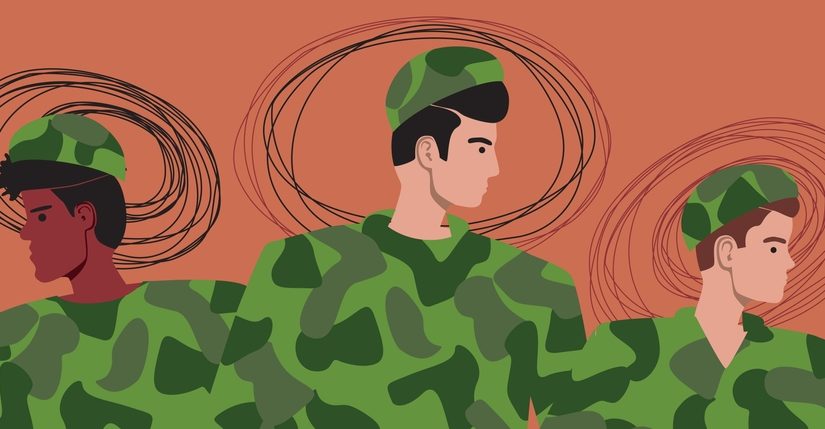- February 28, 2024
- by Shalini Murmu
- PTSD
Dealing with PTSD is like carrying the echoes of tough times with you. Hyperarousal is a heightened state of alertness and reactivity and becomes a constant companion. It’s always there for those going through the maze of post-traumatic stress. To understand this connection, one must know how tough experiences change the way our minds work, leaving a lasting impact on how we feel.
Delving Into The Impact
The impact of hyperarousal on post traumatic stress disorder victims is profound and far-reaching. It’s as if you live in a world where every sound is amplified, every shadow holds a hidden threat, and the simplest of tasks become Herculean challenges. Do you know what the weight of constant vigilance and the toll it takes on your loved ones’ mental and emotional reserves? Hyperarousal triggers can hijack the present moment, transporting people back to the harrowing scenes of their traumatic past, and perpetuating a cycle of distress. The impact extends beyond the individual, affecting relationships, work, and overall quality of life.
To address hyperarousal triggers is to acknowledge the profound relevance of this issue in the broader context of mental health. It’s not an isolated symptom but a key player in the complex interplay of factors that define the mental well-being of a person. By understanding and addressing hyperarousal, we open a gateway to comprehensive healing.
Mental health is a mosaic of interconnected elements, and hyperarousal triggers are a crucial piece of the puzzle. Neglecting this aspect is akin to treating the symptoms while ignoring the root cause. Untreated hyperarousal can have a cascading effect on mental health issues that affect not just the person with PTSD but also everyone in their support network.
Signs Of Hyperarousal
The manifestation of hyperarousal in individuals with PTSD is multi-faceted. Physiologically, it may express itself through an elevated heart rate, rapid breathing, and a heightened startle response. Emotionally, it can manifest as intense anxiety, irritability, and an ever-present sense of impending danger. These responses, once adaptive survival mechanisms, become persistent echoes of trauma, shaping the lens through which individuals perceive the world.
Neurobiological Perspective
Examining the neurobiological perspective unveils a complex interplay of neurotransmitters and disrupted neural circuits resulting from traumatic impact. The amygdala, acknowledged as the brain’s alarm system, assumes a pivotal role, swiftly initiating a cascade of responses in reaction to perceived threats.
A considerable number of changes occur in the neural pathways responsible for regulating the stress response. The prefrontal cortex, essential for executive functions like decision-making and emotional regulation, may encounter challenges in exerting its customary modulating influence. This intricate neurological reality creates a convergence, transforming hyperarousal from a mere psychological response into a tangible neurobiological reality.
Common Triggers
The journey through hyperarousal is marked by encounters with triggers—innocuous stimuli that, for individuals with PTSD, carry the weight of trauma. These triggers can be as subtle as a certain smell, a particular tone of voice, or even a fleeting glimpse of a scene reminiscent of the traumatic event. When one has hyperarousal, the commonplace becomes dangerous, and the environment is a minefield of triggers just waiting to be activated.
Identifying common triggers is an essential step in the path to healing. It requires a nuanced understanding of each person’s unique trauma narrative. For one, it might be the sound of footsteps echoing in a quiet alley; for another, it could be the sight of flashing lights that bring back past emergencies. Each trigger is a whisper from the past, calling forth a visceral response.
Can PTSD Cause Bipolar Disorder?
Researchers have delved into the complex relationship between trauma and mood disorders, exploring whether the events that lead to PTSD could also be factors in the onset of Bipolar Disorder.
Although the field of study is intricate and continuously advancing, some research hints at a possible connection. Trauma, especially in early life, might play a role in triggering Bipolar Disorder in people who are susceptible. The interconnection of these two conditions adds complexity to the story of mental health, underscoring the significance of a comprehensive understanding and personalized interventions for those struggling through this tough times.
Can PTSD Cause Psychosis?
Exploring this connection is like navigating a thick forest, where paths are unclear, and every step requires careful thought. Though the link between PTSD and psychosis is intricate, some studies hint at a potential connection. The intense emotional upheaval and altered perception of reality in PTSD might create a vulnerability to psychotic symptoms. Early-life trauma, in particular, could act as a catalyst, shaping how a person processes and interprets their experiences.
This can lead to states where one might experience hallucinations, delusions, and a distorted sense of self and surroundings. Hallucinations can show up as sensory experiences without any external stimuli—seeing, hearing, or feeling things that others don’t. Delusions involve strongly held false beliefs that resist reasoning or contrary evidence.
Impact Of PTSD On Work
The lingering effects of trauma shape daily interactions and performance. The challenges in professional settings vary widely, often in ways that aren’t immediately apparent. A significant hurdle involves navigating triggers present in the workplace environment. What might otherwise seem harmless including a crowded space or a specific scent can become powerful triggers, thrusting people back into the depths of their traumatic experiences.
The heightened state of alertness typical of PTSD may result in difficulty concentrating, potential memory lapses, and an overall sense of unease.
Interpersonal relationships also present challenges, as individuals with PTSD may grapple with trust issues, struggle to form connections, or fear judgment from colleagues. The stigma linked to mental health can cast a shadow over one’s professional life, adding an extra layer of complexity to an already intricate situation.
What Can Help People With PTSD?
- Effective communication: Keep the lines of communication open and honest with supervisors and colleagues to build understanding. Sharing specific triggers and needs establishes a supportive environment where everyone is well-informed and can contribute to creating a compassionate home or workplace.
- Create a safe space: Designate a quiet and secure space in the workplace or home environment where people can retreat when they feel overwhelmed. This offers a refuge for moments when external stimuli become too much to handle.
- Flexibility in schedules: Advocate for flexible work schedules that cater to the unique needs of people with PTSD. This could involve adjusted start times, breaks as needed, or the option for remote work.
- Wellness programs: Encourage them to programs that address mental health to foster an environment of holistic well-being. This may include access to PTSD counseling services, mindfulness sessions, or mental health days.
- Grounding techniques: Engage in grounding techniques to anchor yourself in the present moment. This can include focusing on sensory experiences, such as touch or breath, to counteract the intrusion of distressing memories.
- Mindfulness practices: Cultivate mindfulness through practices like meditation and mindful breathing. These techniques enhance awareness without judgment, allowing one to observe their thoughts and memories without becoming overwhelmed.
- Memory aids: Utilize external memory aids, such as notes, calendars, or reminders. These tools provide a tangible support system for daily tasks and commitments, reducing the cognitive load on people with PTSD.
- Therapeutic approaches: Explore therapeutic approaches for PTSD treatment, such as Cognitive Behavioral Therapy (CBT) or Eye Movement Desensitization and Reprocessing (EMDR). These modalities target the cognitive distortions and intrusive memories associated with PTSD, offering a path toward recovery.
- Structured routine: Establish a structured routine that provides a sense of predictability and stability. This can assist in creating a supportive environment for memory function and daily functioning.
Hope And Recovery
Amidst the shadows of trauma, hope emerges as a guiding light, revealing the way toward recovery. It’s crucial to foster optimism by emphasizing the potential for improvement through targeted interventions. While the journey may be tough, each step forward serves as a testament to the inner strength within.
- Small victories: Celebrate small victories along the way. Progress in managing hyperarousal triggers may come in incremental steps, and acknowledging these achievements fosters a sense of accomplishment.
- Narrative reframing: Work towards reframing the narrative of trauma. Through therapy and self-reflection, individuals can reshape their understanding of the past, empowering themselves to reclaim agency over their present and future.
- Resilience building: Recognize and cultivate resilience as a foundational aspect of recovery. Resilience is not the absence of struggle but the ability to navigate challenges and bounce back. It’s a quality that can be nurtured and strengthened over time.
- Connection with others: Seek connection with others who have walked similar paths. Sharing experiences with those who understand the journey can provide validation, empathy, and a sense of community.
- Professional guidance: Engage with mental health professionals who specialize in trauma and PTSD. Their expertise, coupled with a compassionate approach, can guide individuals through the intricate process of healing.
Why Seeking Professional Help Is Necessary?
- Mental health professionals bring expertise in assessing and understanding the unique nuances of each individual’s experience. Their assessments form the foundation for tailored interventions that address hyperarousal triggers.
- The therapeutic alliance between individuals and mental health professionals is a powerful catalyst for change. It provides a safe space for exploring emotions, processing trauma, and developing coping strategies.
- Mental health professionals can design interventions specifically tailored to manage hyperarousal triggers.
- In certain cases, medication may be part of the treatment plan. Psychiatric professionals can provide guidance on medications that can help manage symptoms, often in conjunction with psychotherapy.
- Mental health professionals can provide ongoing support, adapting interventions as individuals progress on their healing journey.
Get The Help Today!
If the weight of PTSD feels overwhelming, remember, you don’t have to carry it alone. Take a courageous step towards healing by seeking help from North America Behavioral Health Services – the beacon of compassionate care. Your journey to a more fulfilling life begins with reaching out. We connect you to leading mental health facilities, where understanding professionals stand ready to guide you through the intricate path of recovery. Your well-being matters, and there is strength in seeking support. Embrace the possibility of resilience and renewal.
















